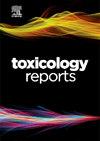Oxidative damage to DNA, expression of Mt-1, and activation of repair mechanisms induced by vanadium trioxide in cultures of human lymphocytes
Q1 Environmental Science
引用次数: 0
Abstract
Vanadium (V) has garnered attention due to its pharmacological properties; however, its toxic effects have also been documented. Among the vanadium compounds that are found in the environment, vanadium trioxide (V2O3) has attracted interest because of its impact on biomolecules such as DNA, RNA, and proteins. However, its precise mechanism of action remains unclear, although it is suspected to be related to oxidative stress. Therefore, this study aimed to determine the mechanisms involved in DNA damage and the associated cellular response pathways. Primary cultures of human lymphocytes were exposed to 2, 4, 8, or 16 µg/mL V2O3. DNA damage due to oxidized bases was evaluated via a comet assay. The expression levels of sensor proteins (ATM and ATR) involved in DNA damage were determined via Western blotting, and the mRNA expression levels of metallothionein 1 (Mt-1) and genes involved in DNA repair (OGG1, APE1, XPB, XPD, MRE11, RAD50, Ku70, and Ku80) were estimated via RT-PCR and qPCR. The results showed that V2O3 is an oxidant that is responsible for DNA damage through oxidized bases, as demonstrated by increased DNA migration in the presence of the FPG enzyme. At the molecular level, V2O3 treatment also increased ATM protein expression. In terms of mRNA expression, the overexpression of Mt-1, OGG1, APE1, Ku70, and Ku80 was observed. This finding suggests that DNA damage is primarily repaired via two mechanisms: base excision repair (BER) and nonhomologous end joining (NHEJ). In conclusion, one mechanism of action of V2O3 involves the oxidation of nitrogenous bases in DNA, the activation of damage sensors (such as ATMs), and the overexpression of Mt-1 as part of the antioxidant response to mitigate the effects of V and facilitate DNA repair pathways (including BER and NHEJ).
三氧化钒诱导人淋巴细胞DNA氧化损伤、Mt-1表达和修复机制激活
钒(V)因其药理特性而备受关注;然而,它的毒性也有文献记载。在环境中发现的钒化合物中,三氧化钒(V2O3)因其对生物分子(如DNA, RNA和蛋白质)的影响而引起了人们的兴趣。然而,其确切的作用机制尚不清楚,尽管它被怀疑与氧化应激有关。因此,本研究旨在确定DNA损伤的机制和相关的细胞反应途径。将人淋巴细胞原代培养物暴露于2,4,8或16 µg/mL V2O3中。氧化碱基引起的DNA损伤通过彗星试验进行评估。Western blotting检测DNA损伤相关传感蛋白(ATM和ATR)的表达水平,RT-PCR和qPCR检测金属硫蛋白1 (Mt-1)和DNA修复相关基因(OGG1、APE1、XPB、XPD、MRE11、RAD50、Ku70、Ku80) mRNA表达水平。结果表明,V2O3是一种氧化剂,通过氧化碱基导致DNA损伤,正如FPG酶存在时DNA迁移增加所证明的那样。在分子水平上,V2O3处理也增加了ATM蛋白的表达。mRNA表达方面,Mt-1、OGG1、APE1、Ku70、Ku80过表达。这一发现表明DNA损伤主要通过两种机制修复:碱基切除修复(BER)和非同源末端连接(NHEJ)。总之,作为抗氧化反应的一部分,V2O3的作用机制包括氧化DNA中的含氮碱基,激活损伤传感器(如atm),以及Mt-1的过表达,以减轻V的影响并促进DNA修复途径(包括BER和NHEJ)。
本文章由计算机程序翻译,如有差异,请以英文原文为准。
求助全文
约1分钟内获得全文
求助全文
来源期刊

Toxicology Reports
Environmental Science-Health, Toxicology and Mutagenesis
CiteScore
7.60
自引率
0.00%
发文量
228
审稿时长
11 weeks
 求助内容:
求助内容: 应助结果提醒方式:
应助结果提醒方式:


